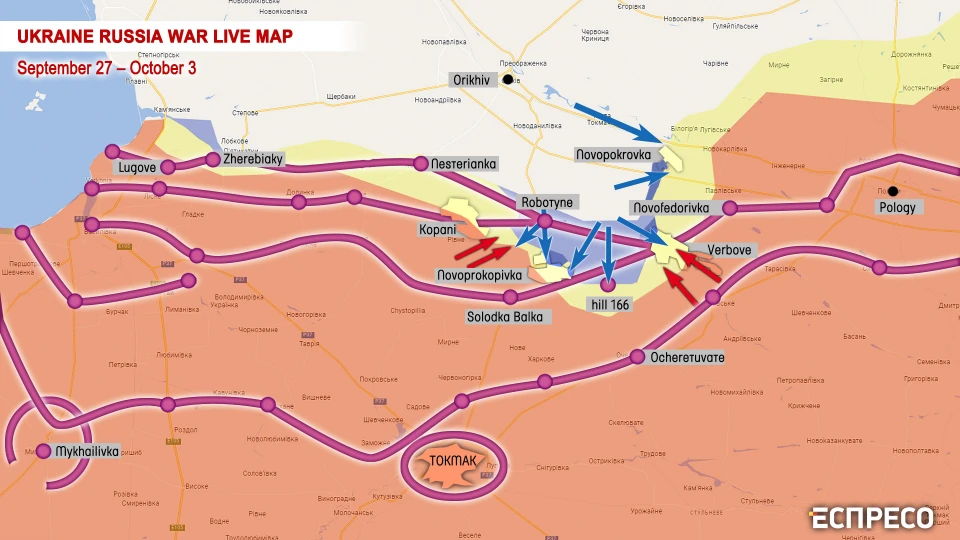
Ukrainian Armed Forces try to open southern land corridor, fighting continues – military expert Zgurets
The enemy has deployed all available reserves to halt our progress at this stage. They are launching counterattacks on the sides, aiming to maintain control of crucial front-line areas that are of great significance to both them and us
Frontline situation
Let's begin with the current frontline situation. As of today, October 3, our General Staff has provided a concise overview of the conditions in the two most intense conflict areas, despite the fact that every kilometer of the ongoing battle against the enemy is incredibly challenging. The report states that the Ukrainian Defense Forces are continuing their advance in the Melitopol and Bakhmut regions. They are inflicting casualties on enemy troops and damaging their equipment while securing positions along the formerly occupied borders, placing significant pressure on the adversary. It's important to note that the southern front, in particular, remains the most precarious.
In fact, if we look at the bigger picture, it appears that the enemy has committed all available reserves at this current stage in an effort to hinder our progress. The adversary is launching counterattacks on the flanks, aiming to maintain control over strategically vital sections of the front, which are crucial for both sides. This is essential for us to establish a route to the south and disrupt the enemy's land corridor. These details were conveyed by the commander of the operational command Tavria. To gain a firsthand perspective on what's transpiring in this part of the front, we turn to a soldier who is witnessing the situation firsthand.

Ihor Hanenko, commander of the mechanized platoon in the 47th separate mechanized brigade, reports that the enemy is reinforcing its troops in the Tavria direction, particularly near the towns of Robotyne and Novoprokopivka. They are mobilizing all available forces to try to stop the advance of the Armed Forces but have been unsuccessful. Russian attempts to retake lost positions have been fruitless because our Defense Forces are firmly holding the reclaimed positions. We will continue to deter the aggressor from taking any further actions, regardless of their plans.
Hanenko also mentioned that the enemy is bringing in fresh reinforcements, consisting of well-prepared units with good morale. Over time, we expect to see a decline in their morale and motivation, as often observed in intercepted communications. For those enemy units that have been in this area for an extended period, motivation and their ability to conduct combat operations are already diminishing.
The fighter also noted that the enemy has been using guided air munitions since the start of the summer campaign. It's important to note that the frequency of aerial bombings hasn't necessarily increased recently; Ukrainian defenders have been experiencing them since June, July, and August. Additionally, both sides recognize the effectiveness of FPV drones, leading to an increase in their usage by both parties.
Hanenko reported a decrease in the number of mines in the area. The enemy is still attempting to lay mines in critical chokepoints, but it's not as widespread as it was earlier in the summer campaign. Currently, what we have are more like mine barriers that partially slow down the advance of our Armed Forces.
He noted that the enemy's tactics have remained consistent since the conflict began. Until our infantry can breach their trenches, regardless of how effective our Ukrainian artillery and equipment are, dislodging the enemy from these entrenched positions is a formidable challenge. This is particularly challenging because the enemy had ample time to fortify these structures, including concrete bunkers and well-dug defensive positions. Nonetheless, our artillery continues its efforts to force the enemy out by intense shelling and targeting these protected structures. The use of FPV drones enhances our precision in these operations, allowing us to destroy or significantly damage these positions.
The serviceman, who serves as the commander of the M2 Bradley infantry fighting vehicle, spoke highly of this machine. The Bradley, along with the Leopard, plays a crucial role in the Ukrainian forces' ability to advance and effectively engage the enemy on Ukrainian soil. These Western machines offer significantly better protection and combat capabilities compared to their Soviet counterparts. The Bradley serves multiple functions, including logistics, transporting and covering infantry during assault operations, and evacuating wounded soldiers. Initially, the Russian forces were unfamiliar with the capabilities of the Bradley infantry fighting vehicle and, in some cases, approached too closely. However, they have since learned to keep their equipment at a safer distance, making it more challenging for us to destroy enemy vehicles.
The commander mentioned that they often launch attacks at night because the Bradley vehicle has an advantage and can see well in the dark. His brigade is always on the offensive and has all the necessary resources. There are numerous videos online showing the 47th mechanized brigade destroying Russian aircraft in the Robotyne and Novoprokopivka area. So, the most effective approach is to target enemy planes when they venture far, and Ukrainian units take them down.
It's worth noting that Ihor Hanenko's brigade initiated offensive operations in the Tokmak direction and is currently handling challenging tasks on the battlefield. We are confident that we possess the capability to break through the enemy's defenses and accomplish the tasks assigned by our commanders as a top priority.
- News














































